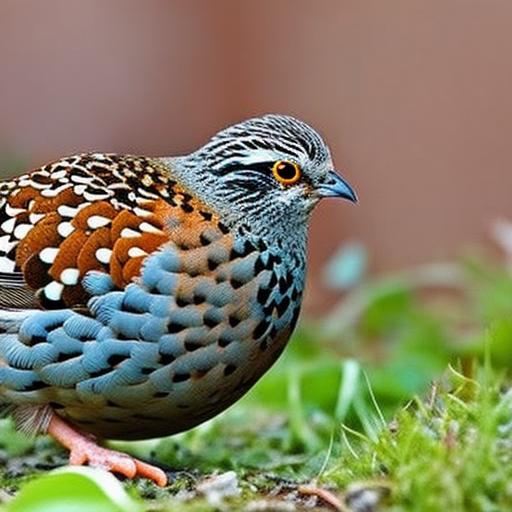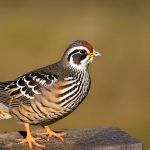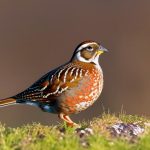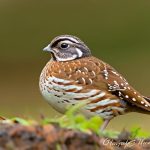Button quail, also known as Chinese painted quail, are small, ground-dwelling birds that are native to Southeast Asia. They are popular among avian enthusiasts for their small size, colorful plumage, and interesting behaviors. Button quail are often kept as pets or for breeding purposes, and they can make a delightful addition to a home aviary or outdoor enclosure. These tiny birds are known for their active and inquisitive nature, and they can be quite entertaining to watch as they forage for food and interact with their environment. In this article, we will explore the various aspects of caring for button quail, including housing and enclosure, diet and nutrition, socialization and interaction, health and wellness, and breeding and reproduction.
Button quail are small birds, typically measuring around 4 inches in length. They come in a variety of colors, including shades of brown, gray, white, and black, with some individuals displaying intricate patterns and markings on their feathers. These birds are known for their distinctive call, which is often described as a series of “button-like” notes, hence their name. Button quail are ground-dwelling birds and are not known for their flying abilities. Instead, they prefer to spend their time foraging for food on the ground, using their strong legs and feet to scratch at the soil in search of insects, seeds, and other small prey. In the wild, button quail are typically found in grasslands, agricultural fields, and scrubby areas, where they can find ample cover and food sources. As pets, button quail require a suitable enclosure that mimics their natural habitat and provides them with space to explore and forage.
Key Takeaways
- Button quail are small, ground-dwelling birds that make great pets for bird enthusiasts.
- When housing button quail, it’s important to provide a secure enclosure with plenty of space for them to move around.
- A well-balanced diet for button quail includes a mix of seeds, insects, and fresh greens.
- Button quail are social birds and should be kept in pairs or small groups for optimal interaction.
- Regular health check-ups and a clean living environment are essential for the overall wellness of button quail.
Housing and Enclosure
When it comes to housing button quail, it’s important to provide them with a suitable enclosure that meets their specific needs. A spacious aviary or outdoor enclosure is ideal for button quail, as it allows them to move around freely and engage in natural behaviors such as scratching, dust bathing, and foraging. The enclosure should be constructed of sturdy materials that can withstand the birds’ scratching and pecking behaviors, and it should be secure to prevent escapes and protect the quail from predators. The flooring of the enclosure should be covered with a substrate such as sand, soil, or wood shavings, which will allow the quail to engage in natural foraging behaviors and help maintain good foot health.
In addition to a suitable substrate, the enclosure should also include plenty of hiding spots and cover in the form of plants, shrubs, or artificial structures. Button quail are naturally shy and skittish birds, so having places to hide and feel secure is important for their well-being. Providing a variety of perches and platforms at different heights will also give the quail opportunities to exercise and explore their environment. It’s important to regularly clean the enclosure to maintain good hygiene and prevent the buildup of waste and bacteria. Fresh water should always be available to the quail, provided in shallow dishes or waterers that are easy for the birds to access without risk of drowning. Overall, a well-designed and spacious enclosure is essential for the health and happiness of button quail in captivity.
Diet and Nutrition
Button quail have specific dietary requirements that must be met in order to keep them healthy and thriving in captivity. In the wild, these birds primarily feed on a diet of insects, seeds, and small plants that they find while foraging on the ground. In captivity, it’s important to replicate this natural diet as closely as possible to ensure that the quail receive the proper nutrients they need to stay healthy. A high-quality game bird or finch feed can serve as the base of the quail’s diet, providing essential vitamins, minerals, and protein. In addition to commercial feed, button quail should also be offered a variety of fresh foods such as chopped vegetables, fruits, mealworms, and small insects to supplement their diet.
It’s important to provide a balanced diet that includes a mix of protein, carbohydrates, fats, vitamins, and minerals to support the overall health of the quail. Additionally, offering access to grit or small stones is important for button quail, as it helps them grind up their food in their gizzards for proper digestion. Fresh water should always be available to the quail, as they have high water requirements due to their small size and active nature. It’s important to monitor the quail’s food intake and adjust their diet as needed based on their activity level, breeding status, and overall health. By providing a varied and nutritious diet, button quail can thrive in captivity and display their natural behaviors.
Socialization and Interaction
Button quail are social birds that thrive in the company of their own kind. In the wild, they form small flocks or pairs and engage in social behaviors such as preening each other, dust bathing together, and vocalizing to communicate. In captivity, it’s important to provide button quail with opportunities for socialization and interaction with other quail to support their mental and emotional well-being. Keeping button quail in pairs or small groups is ideal, as it allows them to engage in natural social behaviors and form strong bonds with their companions.
When introducing new quail to an existing group or pair, it’s important to monitor their interactions closely to ensure that they get along well and do not display aggressive behaviors towards each other. Providing plenty of space, hiding spots, and enrichment in the form of toys or foraging activities can help reduce stress and promote positive social interactions among button quail. Additionally, spending time observing and interacting with the quail can help build trust and strengthen the bond between the birds and their caretakers. By providing a stimulating environment and opportunities for socialization, button quail can lead fulfilling lives in captivity.
Health and Wellness
Maintaining the health and wellness of button quail is essential for their long-term well-being in captivity. Regular health checks should be conducted to monitor the quail’s overall condition, including their weight, feather quality, behavior, and droppings. Any signs of illness or injury should be addressed promptly by a qualified avian veterinarian to ensure that the quail receive proper treatment and care. It’s important to provide a clean and hygienic environment for the quail, including regular cleaning of the enclosure, providing fresh water daily, and removing any soiled bedding or food promptly.
In addition to physical health, it’s important to consider the mental well-being of button quail in captivity. Providing enrichment activities such as foraging toys, hiding spots, and opportunities for socialization can help prevent boredom and reduce stress in the birds. Monitoring the quail’s behavior for signs of stress or anxiety is important, as these can impact their overall health and quality of life. By providing a balanced diet, regular veterinary care, a clean environment, and opportunities for mental stimulation, button quail can lead healthy and fulfilling lives in captivity.
Breeding and Reproduction
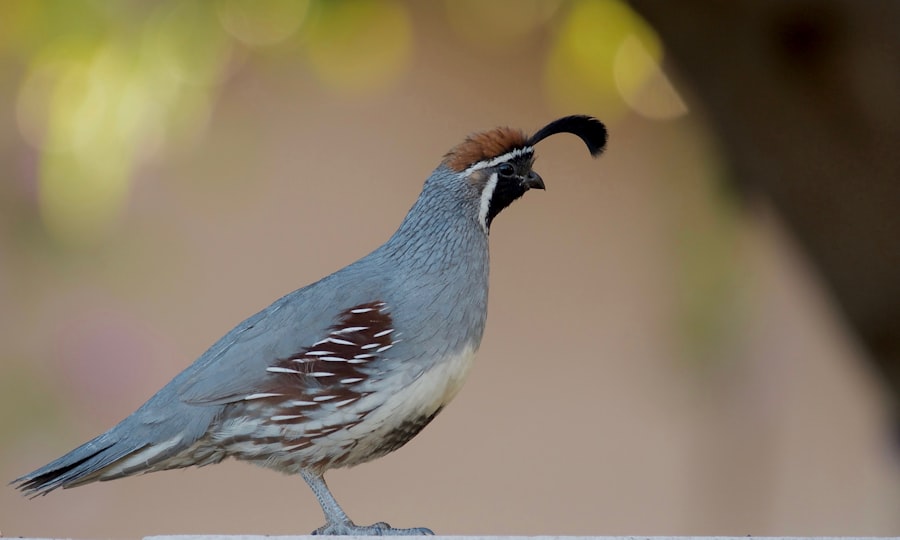
Breeding button quail can be a rewarding experience for avian enthusiasts who are interested in expanding their flock or producing offspring for sale or exhibition. Button quail are relatively easy to breed in captivity given the right conditions and care. When breeding button quail, it’s important to provide a suitable nesting area within the enclosure where the female can lay her eggs in privacy. This can be achieved by providing a shallow dish filled with soft nesting material such as hay or shredded paper.
Once the eggs are laid, they should be carefully monitored for signs of fertility and development. Incubating the eggs using an appropriate avian egg incubator can increase the chances of successful hatching. It’s important to provide proper care for the parent birds during the breeding process by ensuring they have access to a nutritious diet, clean water, and a stress-free environment. Additionally, providing ample space within the enclosure can help reduce territorial disputes between breeding pairs. By following these guidelines and providing proper care during the breeding process, avian enthusiasts can successfully breed button quail in captivity.
Conclusion and Considerations
In conclusion, button quail are fascinating birds that can make delightful additions to a home aviary or outdoor enclosure. By providing a suitable housing environment that mimics their natural habitat, a balanced diet that meets their nutritional needs, opportunities for socialization and interaction with other quail, regular veterinary care to maintain their health and wellness, and proper care during the breeding process; avian enthusiasts can ensure that button quail thrive in captivity. It’s important to consider the specific needs of button quail when caring for them in captivity in order to provide them with a fulfilling life. With proper care and attention to their needs, button quail can bring joy and entertainment to avian enthusiasts while thriving in captivity.
If you’re considering keeping button quail as pets, it’s important to provide them with a suitable living environment. A well-designed coop, such as the Snaplock Chicken Coop from Poultry Wizard, can offer the perfect space for these small birds to thrive. Additionally, ensuring that the coop is equipped with a reliable heater, like the one recommended in Poultry Wizard’s article on heating for a chicken coop, can help maintain a comfortable temperature for your quail. For further insights on caring for poultry, including ducks, Poultry Wizard’s guide on what to feed ducks can provide valuable information on meeting their dietary needs.
FAQs
What are button quail?
Button quail, also known as Chinese painted quail, are small ground-dwelling birds native to Southeast Asia. They are popular as pets due to their small size and colorful plumage.
What do button quail eat?
Button quail are omnivorous and eat a variety of foods including seeds, insects, and small plants. In captivity, they can be fed a diet of commercial game bird feed, supplemented with fresh fruits and vegetables.
How big do button quail get?
Button quail are small birds, typically reaching a size of 4-5 inches in length. They are known for their compact and round appearance.
What kind of habitat do button quail need?
Button quail require a spacious enclosure with plenty of room to move around. They also need a substrate that allows them to dust bathe, such as sand or fine gravel. Additionally, they need access to hiding spots and places to perch.
Are button quail social animals?
Button quail are social birds and are best kept in pairs or small groups. They are known for their gentle and non-aggressive nature, making them suitable for communal living.
What is the lifespan of button quail?
In captivity, button quail can live for 5-7 years with proper care and attention to their needs. Providing a balanced diet, a suitable habitat, and regular veterinary check-ups can help ensure a long and healthy life for these birds.
Meet Walter, the feathered-friend fanatic of Florida! Nestled in the sunshine state, Walter struts through life with his feathered companions, clucking his way to happiness. With a coop that’s fancier than a five-star hotel, he’s the Don Juan of the chicken world. When he’s not teaching his hens to do the cha-cha, you’ll find him in a heated debate with his prized rooster, Sir Clucks-a-Lot. Walter’s poultry passion is no yolk; he’s the sunny-side-up guy you never knew you needed in your flock of friends!

